Progress towards net zero emissions by 2045
Victoria has cut emissions by almost a third since 2005
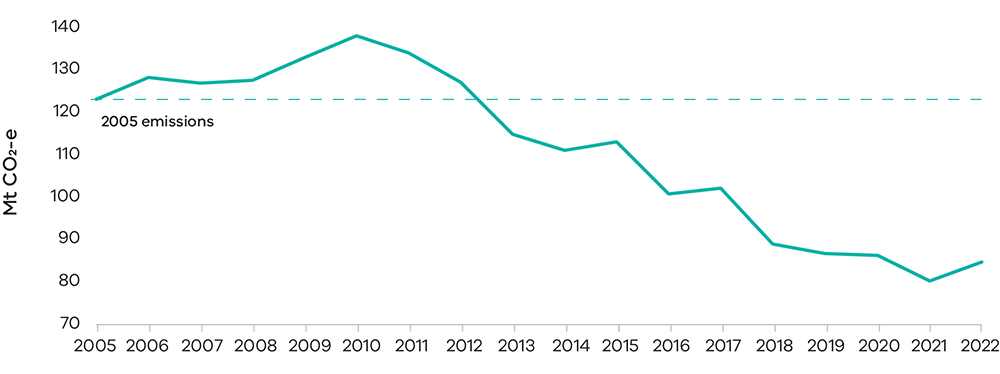
Victoria’s net greenhouse gas emissions for 2022 were 84.7 megatonnes of carbon dioxide equivalent (Mt CO2-e). This is a 31.3% reduction in emissions from 2005 levels. This is within the 2025 target range of reducing Victoria’s emissions by 28-33% below 2005 levels.
Find out more about Victoria’s emissions reduction targets.
Victorians emit fewer greenhouse gases than the national average
Victorians emit 12.8 tonnes (t) CO2-e per person on average. This is below the national average and the average of all states and territories other than Tasmania, South Australia and the Australian Capital Territory.
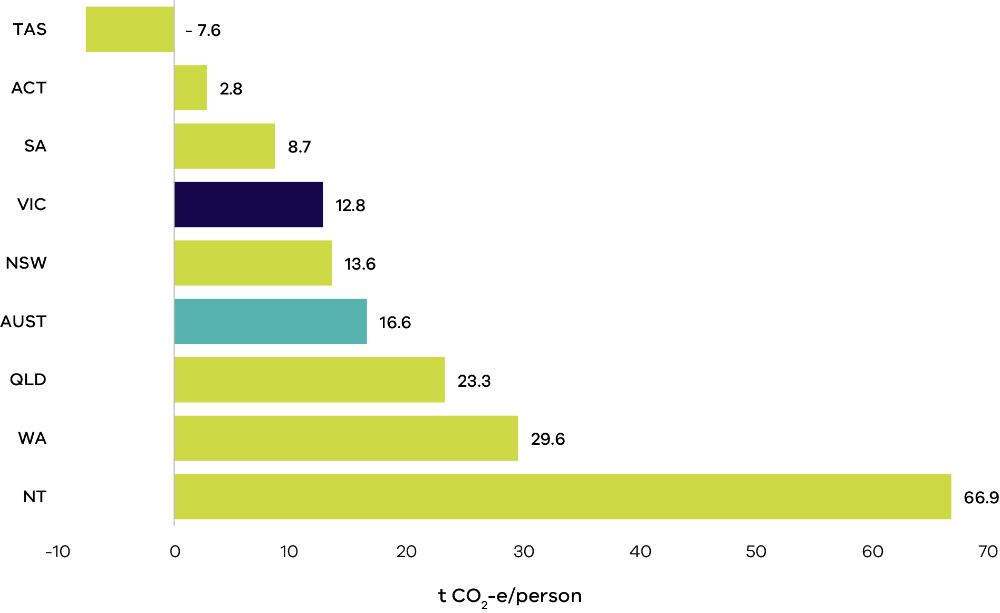
Victoria's greenhouse gas emissions by sector in 2022
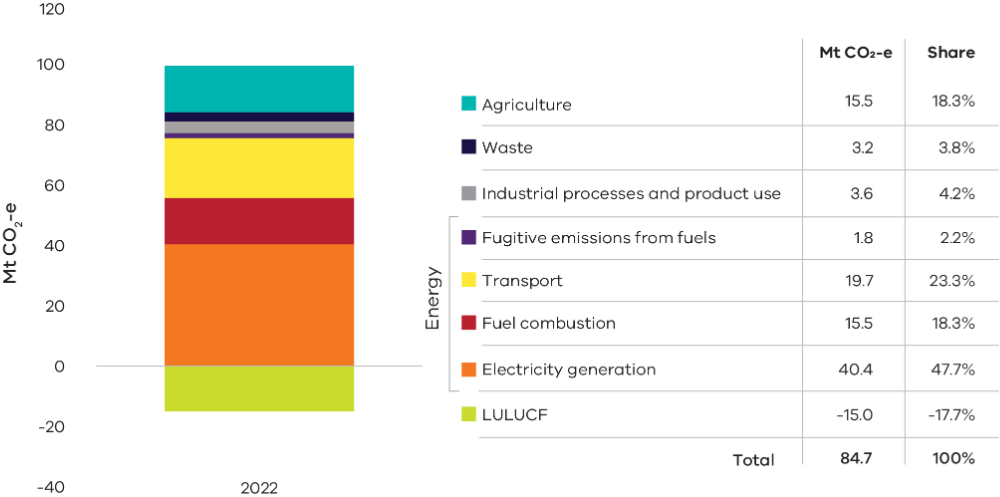
Sector | 2022 emissions (Mt CO2-e) | Share |
|---|---|---|
Agriculture | 15.5 | 18.3% |
Waste | 3.2 | 3.8% |
Industrial processes and product use | 3.6 | 4.2% |
Fugitive emissions from fuels | 1.8 | 2.2% |
Transport | 19.7 | 23.3% |
Fuel combustion | 15.5 | 18.3% |
Electricity generation | 40.4 | 47.7% |
LULUCF | -15.0 | -17.7% |
Total | 84.7 | 100% |
Where Victoria's emissions come from
More than 90% of Victoria’s net greenhouse gas emissions* comes from burning fossil fuels to make energy. This energy is used for electricity, transport and fuel combustion.
Electricity is the top contributor to the state’s emissions – making up 48% of the state’s net emissions. The use of fossil fuels in transport contributes 23% of Victoria’s net emissions. Burning fossil fuels in homes, businesses and industry contributes 18%.
Aside from fossil fuels, other sources of Victoria’s emissions are:
- emissions from Agriculture, at 18% of Victoria’s net emissions. This is mostly methane, which is burped out by cows and sheep
- industrial process and product use emissions at 4% of the state’s net emissions. This is the release of human-made chemicals into the atmosphere
- emissions from waste are also responsible for 4% of net emissions. This is mostly methane released from landfills and wastewater treatment plants.
The Land Use, Land Use Change and Forestry (LULUCF) sector contributes negative 18% to Victoria’s net emissions in 2022. This is because it accounts for trees and other plants, which absorb carbon dioxide as they grow.
*Victoria’s net emissions are the sum of emissions from all sources minus absorption of carbon emissions from trees and plants in the LULUCF sector. This absorption of carbon emissions means that the sources of emissions add up to more than 100%.
The transition to renewable energy continues to decarbonise electricity
In 2022, Victoria’s renewable energy generation reached 34% of electricity generation (see Victorian Renewable Energy Target 2021/22 Progress Report for more detail). Meanwhile brown coal power plants have closed, which has resulted in a 36% reduction of emissions since 2005 from the electricity sector.
Industry has reduced its fossil fuel use
Fossil fuel combustion has decreased since 2005 by 16%. This is primarily due to the reduction in energy intensive manufacturing in Victoria.
The extraction and production of fossil fuels have also decreased, which reduces overall fossil fuels use. This then results in fugitive emissions declining by 21% since 2005.
Transport emissions have rebounded following COVID-19 restrictions
As COVID-19 restrictions were lifted, transport emissions rebounded in 2022 – increasing by 6% compared to 2021. Whilst this is an increase, transport emissions in 2022 are still 13% lower than they were in 2019, before the pandemic.
Victoria contributes around one fifth of Australia’s emissions
Victoria’s emissions account for 19.6% of Australia’s national emissions. This makes Victoria the third largest state or territory contributor to national emissions.
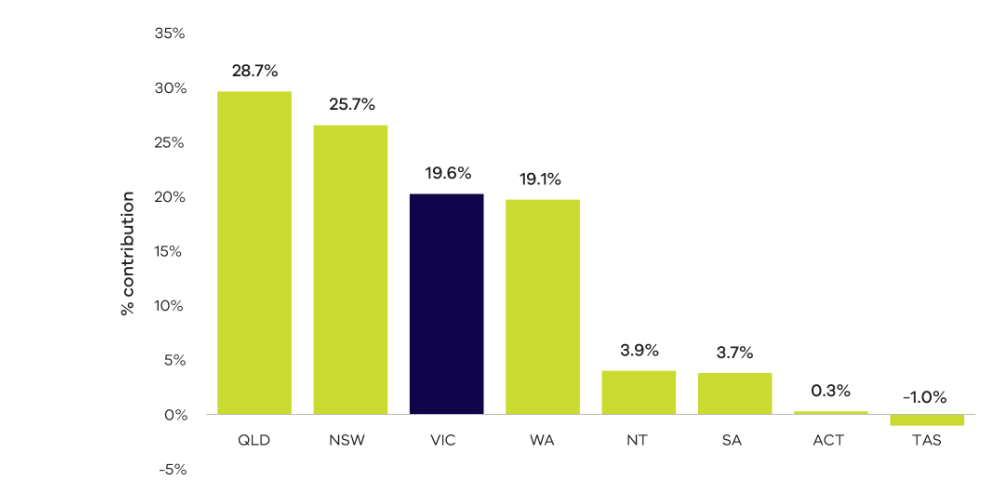
Victoria’s population and economy are growing, yet emissions are falling
Victoria’s emissions have been trending down since 2010. Meanwhile, Victoria has continued to grow – with its Gross State Product (GSP) increasing by 141% and population by 51% since 1990. GSP measures the value of goods and services produced in Victoria and is a metric that represents the size of Victoria’s economy.
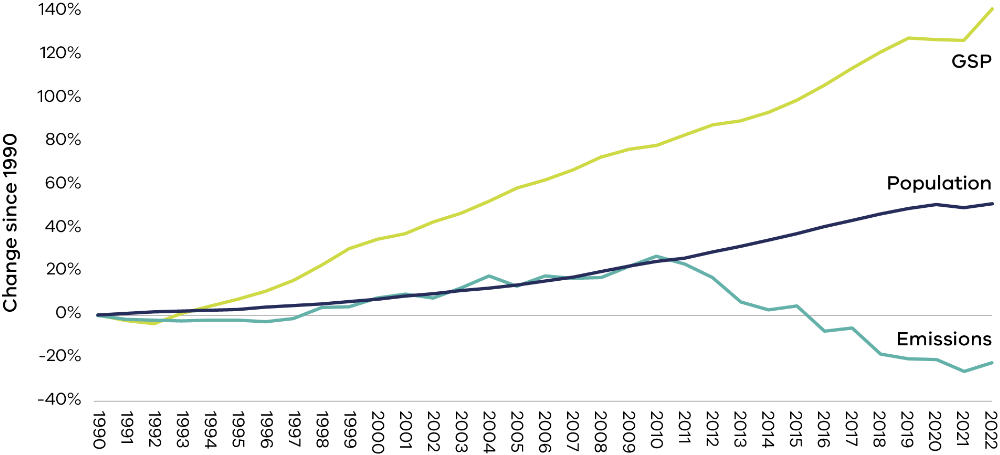
Greenhouse gas emissions resources
The Victorian Government publishes a report every year on Victoria’s greenhouse gas emissions. The report uses data prepared by the Commonwealth Department of Climate Change, Energy, Environment and Water (DCCEEW), in line with internationally agreed rules: Emissions reporting - DCCEEW.
To learn more about Victoria’s emissions and how we are tracking towards net zero emissions by 2045, use the following resources.
Downloads
- Victorian Greenhouse Gas Emissions Report 2022 (PDF, 1.8 MB)
- Victorian Greenhouse Gas Emissions Report 2022 - accessible (DOCX, 511.5 KB)
- Victorian Greenhouse Gas Emissions Report 2022 - chart data (Excel, 466.3 KB)
Previous editions of the Greenhouse Gas Emissions Report
- Victorian Greenhouse Gas Emissions Report 2021 (PDF, 5.5 MB)
- Victorian Greenhouse Gas Emissions Report 2021 - accessible (DOCX, 7.9 MB)
- Victorian Greenhouse Gas Emissions Report 2020 (PDF, 2.7 MB)
- Victorian Greenhouse Gas Emissions Report 2019 (PDF, 3.8 MB)
- Victorian Greenhouse Gas Emissions 2018 (PDF, 1.5 MB)
- Victorian Greenhouse Gas Emissions 2017 (PDF, 1.8 MB)
- Victorian Greenhouse Gas Emissions 2016 (PDF, 2.4 MB)
Updates to the way emissions are calculated
The Commonwealth Department of Climate Change, Energy, the Environment and Water (DCCEEW) makes improvements to emissions methods in response to new data, improved science, and review by international experts.
The new methods are required to be used to recalculate old emissions data. These changes apply to all years from 1990 onwards. This means that method improvements can change Victoria’s emissions in 2005, which is the baseline year for Victoria’s interim emissions reduction targets.
Further details are available in the Victorian Greenhouse Gas Emissions Report 2022.
Contact us
Contact us via email climate.change@deeca.vic.gov.au
Notes
To simplify comparisons across various greenhouse gases, they are expressed in terms of carbon dioxide equivalent (CO2-e), which indicates the amount of carbon dioxide that would cause the same amount of global warming over a 100-year period.
This data covers financial years, with 2022 referring to the period from 1 July 2021 to 30 June 2022.
Page last updated: 05/09/25